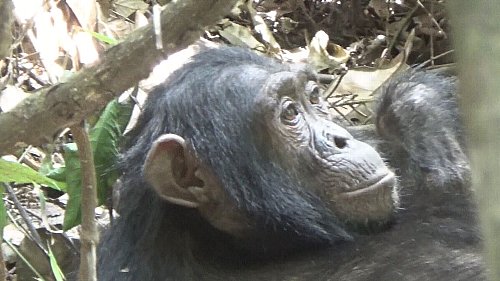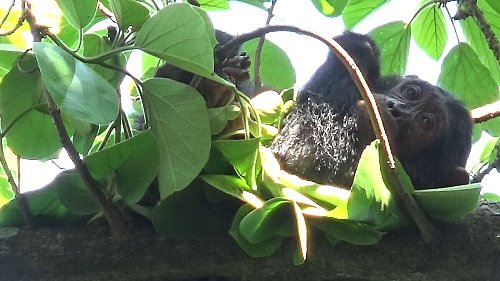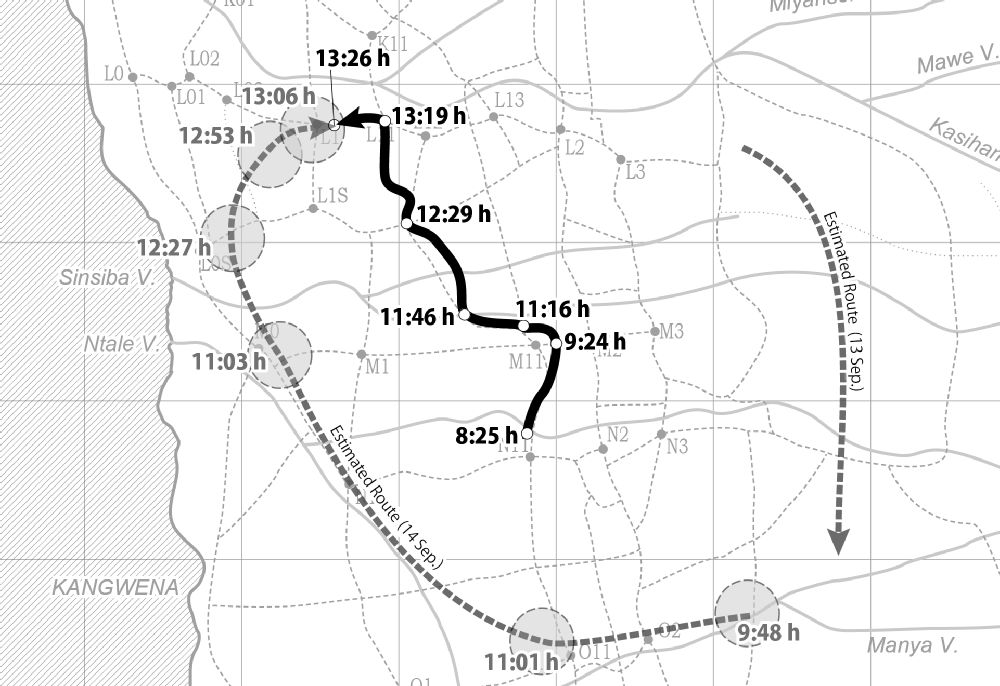|
<NOTE>
Published online (March 17, 2019)
A five-year-old chimpanzee ranged alone: Reconsidering independence in ranging
Michio Nakamura1 & Hitonaru Nishie1,2
1 Graduate School of Science, Kyoto University, Japan 2 JSPS Research Fellow, Japan INTRODUCTION Chimpanzees (Pan troglodytes) have a long period of dependency when they are immature. Dependence on the mother may have various aspects. Infants are dependent for almost every aspect: nutrition, transportation, hygiene, and thermoregulation. Nutritional independence seems to be achieved at around their third year but infants continue to suckle the nipple to around fourth to fifth year of age (Matsumoto 2017). After weaning, offspring is considered to enter juvenility. He/she is no more carried by the mother and eats by himself/herself. Still, juveniles are thought to be dependent in ranging as they are almost always together with their mothers (Pusey 1983; Hayaki 1988). Thus, in many studies about chimpanzee ranging behavior or party size, infants and juveniles are “not counted as independent animals” (Doran 1997). Even if not the mother, a juvenile still needs somebody to be near. When a juvenile is away from its mother, he/she follows other adults or stays in a larger party (Pusey 1983). In a rare case when a five-year-old juvenile male was left behind by his mother who emigrated to a neighboring group for ten months, he was almost always observed to be together with a particular adult male (Hiraiwa-Hasegawa & Hasegawa 1988). Thus, even when juveniles are away from mothers, they are still with somebody else and are “virtually never alone” (Pusey 1990). Orphans are of special interest in terms of dependency on adults (Nakamura et al. 2014). At Mahale, three-year-old orphans may survive (Nakamura & Hosaka 2015). Such infant orphans are often “adopted” by some non-mothers (Boesch et al. 2010; Nakamura & Hosaka 2015). Orphans are also dependent on their “adoptive mothers” to be carried, groomed, or shared the beds with. Although juvenile orphans are not “adopted” in such a way, they usually need to follow someone. Hayaki (1988) noted that “young orphans seem to need an attachment to a particular individual.” Although such particular partners were sometimes less obvious (Nakamura & Hosaka 2015), juvenile orphans had been always observed in a ranging party containing at least one adult. Here we report two cases of a five-year-old orphan female at Mahale who seemed to have ranged completely alone. These cases may provide us information to reconsider what independence in chimpanzees’ ranging is. METHODS The study was conducted on the M group chimpanzees at the Mahale Mountains National Park, Tanzania in August and September 2018. The orphaned juvenile in question, Quinoko (Figure 1), was born in January 2013, thus 5 years and 7–8 months old (onset of juvenility) at the time of the observations. Her mother had died in January 2018 (7–8 months earlier). Her elder sister (born in 2006) also used to take care of Quinoko in her infancy but had disappeared (probably emigrated) one month prior to the mother’s death. Thus, Quinoko no more had maternal kin in the M group. 
OBSERVATIONS Case 1 On August 20th, 2018, HN and a research assistant were searching for chimpanzees in the flatter area within the M group’s home range since morning. They could not hear any vocalizations. At 9:47 h they split into two parties to look for chimpanzees in different locations. Soon, the assistant found Quinoko on a tree. He followed her for a while as she moved eastward on trees. The assistant gave up following Quinoko when she went off the trail to the east. At 10:29 h, HN and the assistant reunited and searched for other chimpanzees. They could only find two adult females at 14:39 h at a different place about 1.5 km from where Quinoko had been witnessed. Judging from circumstantial evidence, it seemed that the majority of chimpanzees were high up in the mountain. Case 2 On September 13th, 2018, the majority of M-group chimpanzees went up to the east in the morning. Judging from the vocalizations, they continued to move southward in the high mountain on the day (Figure 2, a dotted line to the right). Figure 2. Ranging of Quinoko on 14th Sep. 2018 relative to other chimpanzees’ movement Quinoko’s travel route is shown in thick black arrow. White circles indicate the locations where she crossed observation trails. Other chimpanzees’ estimated routes (on 13th and 14th) are shown in dotted grey arrows. Grey dotted circles indicate estimated locations of vocalizations heard while following Quinoko on 14th. One grid corresponds to 0.5 km by 0.5 km. On September 14th, MN was heading to where he can hear vocalizations assuming large party was still on the mountain. Along the way, at 8:25 h, he found Quinoko alone on a tree eating Saba comorensis fruits (Figure 2). As MN followed her, Quinoko moved northward through trees, sometimes eating Saba and Pycnanthus angolensis fruits. At 9:37 h she made a humble bed on a high Cordia tree and lay down on it (Figure 3). At 9:48 h, chimpanzee vocalizations were heard from far southeast (still high in the mountain). Quinoko did not show any response. At 10:00 h she started to move again and ate Saba. She again rested at 10:39 h. At 11:01 h, chimpanzee calls were heard again, this time from far south but it seems they climbed down to flatter area. Soon afterward at 11:03 h, vocalizations came from west-northwest (someone may have preceded the main party). Still, Quinoko did not respond. At 11:13 h, she started to move and ate Saba and Pycnanthus on the way. 
At 12:27 h, many vocalizations came from the west. This time they were much closer. Quinoko finally vocalized at 12:29 h: a whimper-like “hu hu” then a pant-hoot without a climax. The other chimpanzees’ calls were intermittently heard, mostly from west. It seems the large nomadic party was spreading widely and approaching. Quinoko still moving through trees, headed north to the northwest while she replied four times to the vocalizations. At 12:56 h, she was high up in a tree looking at the direction of the voices. By 13:19 h she was completely within the range of widespread chimpanzees but still did not physically meet any. At 13:26 h, she finally descended to the ground, ran on the trail, and pant-grunted to an adult male Carter who came from the west. After this reunion, Quinoko continued to move in this nomadic party until the evening. DISCUSSION It is unusual for a five-year-old juvenile to range alone, even considering that Quinoko was an orphan. In Case 1, although the observation time was short, it is likely that Quinoko had long been alone because we did not see other chimpanzees nearby despite a deliberate search. In Case 2, Quinoko was alone at least for five hours. Because most chimpanzees had been in the higher area since the day before, and we found her in the morning, we believe that she had stayed alone since the day before. Pusey (1983) noted that one of the reasons why juveniles follow mothers is a need to learn how to find and process numerous seasonal and widely dispersed foods. This means juveniles are still dependent because they lack sufficient knowledge for foraging. However, as we observed in Case 2, Quinoko ate fruits several times and did not seem to have difficulty in finding and eating fruits. At this time, Saba and Pycnanthus, both Mahale chimpanzees’ major foods, were beginning to fruit in many places. Thus in such a season, the demerit of being alone on foraging may not be so obvious. Still, Quinoko’s ranging behavior was not completely same as usual. Notably, she never descended on the ground while she was alone. In Case 2, she moved around 2 km only through trees. This is unlikely when we follow an adult chimpanzee ranging alone. Because at Mahale, tree canopies are often sparse, there seems to be a certain cost to move a long distance without descending on the ground. Quinoko actually seemed to incur extra costs to detour to the place where a branch is close to branch of the next tree or to jump from a tree to the next. It is possible that presence of the human observers may be the reason that she did not descend on ground. However, Quinoko is not usually so shy and did not show any nervous attitude toward us or try to flee. Thus, she might rather have had some unspecified anxiety. Despite such possible anxiety, Quinoko never whimpered or made distress calls when she was far from others. This is contrasting to the situation when a similaraged non-orphan gets lost. He/she would loudly whimper and scream and deliberately search for the mother (Hayaki 1988; Matsusaka 2003). An orphan also whimpers when he/she temporarily loses sight of the chimpanzee whom he/she is following. This may mean that juvenile chimpanzees do call only when there is somebody close enough to hear them. It is understandable that a chimpanzee does not call when he/she is completely alone not to attract predators. Although juvenile chimpanzees almost always range with others, our observations suggest that they can be independent in some situations. It is unknown whether Quinoko chose to be alone (because she was harassed by others, for example) or was accidentally alone (i.e., got lost) for some reason. She ranged for a long time and did not seem to have difficulty in finding food. Still, as she never descended on the ground and kept moving on trees, it is suggested that ranging alone may cause some anxiety. This may be a proximate reason that juveniles are virtually never alone. ACKNOWLEDGMENTS We would like to thank the Tanzania Commission for Science and Technology, the Tanzania Wildlife Research Institute, and the Tanzania National Parks for the permissions to conduct field research at Mahale. We thank Dr. T. Matsusaka for comments on the manuscript. The study was supported by the MEXT/JSPS kakenhi JP15H04429, #4903 JP17H06381, JP26284138 (to MN), and 17J40059 (to HN). REFERENCES Boesch C, Bolé C, Eckhardt N, Boesch H 2010. Altruism in forest chimpanzees: The case of adoption. PLOS One 5: e8901. https://doi.org/10.1371/journal.pone.0008901 Doran D 1997. Influence of seasonality on activity patterns, feeding behavior, ranging and grouping patterns in Taï chimpanzees. Int J Primatol 18: 183–206. https://doi.org/10.1023/A:1026368518431 Hayaki H 1988. Association partners of young chimpanzees in the Mahale Mountains National Park, Tanzania. Primates 29: 147–161. https://doi.org/10.1007/BF02381119 Hiraiwa-Hasegawa M, Hasegawa T 1988. A case of offspring desertion by a female chimpanzee and the behavioral changes of the abandoned offspring. Primates 29: 319–330. https://doi.org/10.1007/BF02380955 Nakamura M, Hayaki H, Hosaka K, Itoh N, Zamma K 2014. Orphaned male chimpanzees die young even after weaning. Am J Phys Anthropol 153: 139–143. https://doi.org/10.1002/ajpa.22411 Nakamura M, Hosaka K 2015. Orphans and allomothering. In: Mahale Chimpanzees: 50 Years of Research. Nakamura M, Hosaka K, Itoh N, Zamma K (eds), Cambridge University Press, Cambridge, pp. 421–432. Matsumoto T 2017. Developmental changes in feeding behaviors of infant chimpanzees at Mahale, Tanzania: Implications for nutritional independence long before cessation of nipple contact. Am J Phys Anthropol 163: 356–366. https://doi.org/10.1002/ajpa.23212 Matsusaka T 2003. [Where’s mom?: An episode of a stray chimpanzee.] Mahale Chimpun 2: 5–6. Pusey AE 1983. Mother-offspring relationships in chimpanzees after weaning. Anim Behav 31: 363–377. https://doi.org/10.1016/S0003-3472(83)80055-4 Pusey AE 1990. Behavioral changes at adolescence in chimpanzees. Behaviour 115: 203–246. https://doi.org/10.1163/156853990X00581 Received: 23 October 2018 Accepted: 12 March 2019 Back to Contents |
